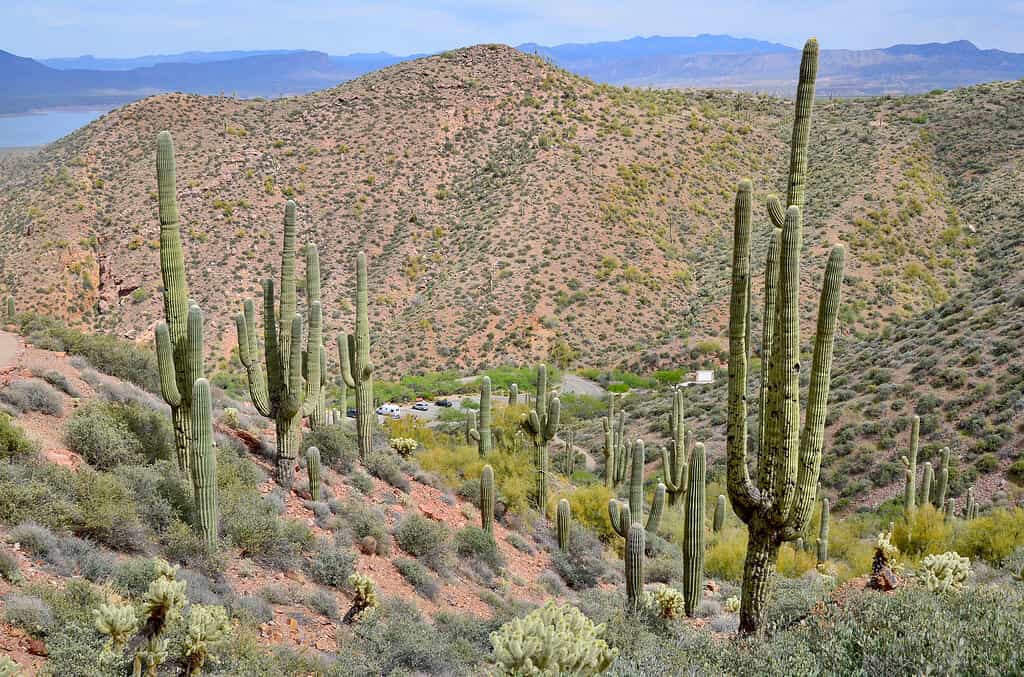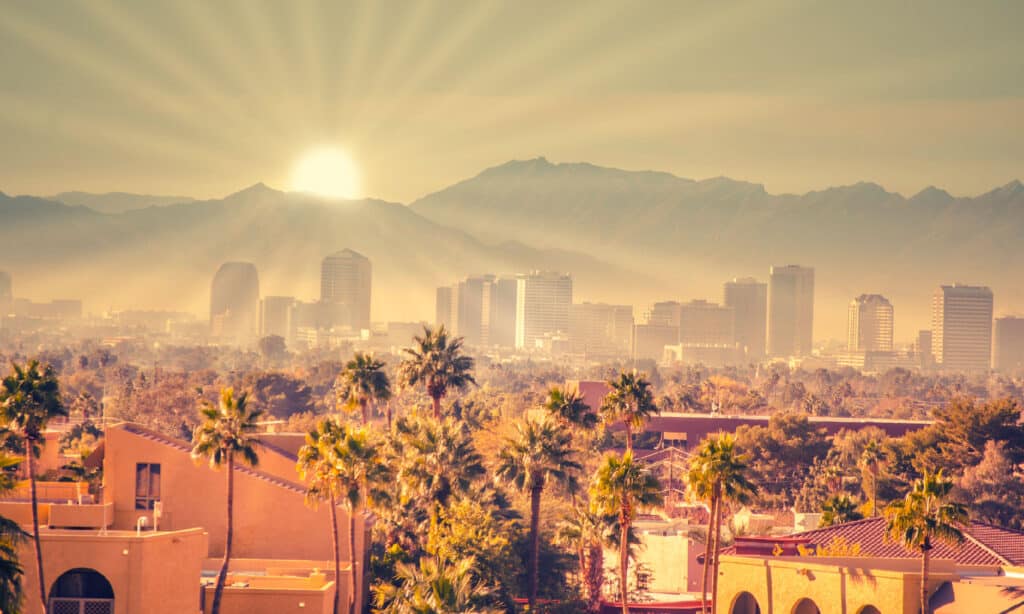It’s common knowledge that some of Arizona is a hot desert with extreme temperatures. Even though Arizonans expect soaring temperatures between May and October, the hottest June in Arizona history was a sizzling nightmare. How hot did it get, and how did the population fare? Let’s dive into the details.
When Was the Hottest June in Arizona History?

Phoenix, Arizona, hit 122 degrees Fahrenheit on June 26, 1990.
©Globe Guide Media Inc/Shutterstock.com
The hottest June in Arizona history occurred in 1974, when it was over 110 degrees Fahrenheit for 18 days. These days stretched from June 12 to June 25, and only one day that month was under 100 degrees Fahrenheit. The hottest temperature during that time was 116.1 degrees Fahrenheit on June 24.
While the hottest June in Arizona occurred in 1974, the hottest individual day occurred in a different year. The hottest Arizona temperature ever recorded was at Lake Havasu on June 29, 1994, at 128 degrees Fahrenheit. The 128-degree day may have occurred on June 28, as the National Weather Service reported temperatures the next day.
On June 26, 1990, Phoenix hit 122 degrees Fahrenheit. While it was sizzling hot for a few days, the heatwave wasn’t as extended as the searing nightmare that existed in 1974. Despite this, 1990 is remembered by most Arizonans in the Phoenix Valley as the year with the hottest day.
What Caused the Hottest June in Arizona?

Long-lasting high-pressure systems sometimes cause oppressive heat in Arizona.
©meunierd/Shutterstock.com
Arizona’s hottest June on record was a result of an exceptionally long-lasting overhead high-pressure system. A high-pressure system involves hot air being trapped beneath cold air, and as hot air rises, the cool air sinks. Cool air gradually moves toward the ground though this process can be exceptionally slow under the right conditions.
This pocket of sinking cool air creates clear days but also allows unrestricted sun rays to blast the state. The hottest June in Arizona was 3.8 degrees warmer than the average June temperature.
Arizona is no stranger to sizzling heat because what makes Phoenix such a nightmare functions the same every season. June is particularly intolerable because the monsoon season hasn’t started yet the heat has arrived. Respite days from some of the hottest temperatures in the nation that show up in Arizona are few.
Were Arizonans Impacted by the Hottest June in State History?
Arizonans were uncomfortable in June 1974 though their lives were not dramatically impacted because the power didn’t go out. Air conditioning was introduced to Arizona in the 1940s, which fueled population growth. Most homes in Phoenix had some form of climate control by the 1960s, with most new builds in that era containing central heat and air.
Were Arizonans Prepared for the Sizzling Nightmare Summer in June 1974?

There were no disruptions in water supply during the June 1974 heatwave in Arizona.
©iStock.com/Monica Lara
Arizonans were prepared for the hot weather that showed up during the June of 1974. There were no notable power outages or disturbances in water supplies. Because of this, residents were able to get through this prolongated heatwave.
People were dealing with sizzling Arizona summers well before the invention of air conditioning, and most seasoned desert dwellers know a few tricks. If the air conditioning goes out during a power failure, sheets dipped in water should be hung over open windows to cool the incoming air. Fans can be blown over ice in a sealed house if the air conditioning has gone out, but there is still electricity in the home.
Screened-in porches, sometimes called Arizona or sleeping porches, were sometimes a feature on old housing predating the 1940s. Beds were moved to these porches for the summer to avoid the lingering heat within the home.
Was Infrastructure Impacted During Arizona’s Hottest June?

The Urban Heat Island in Phoenix traps daytime heat in the city at night.
©Amine Abassir, CC BY-SA 4.0, via Wikimedia Commons – License
The city’s infrastructure was not affected by the hottest June in 1974. However, the existing infrastructure before the heatwave most likely contributed to the sustained high temperatures.
Due to a phenomenon known as the Urban Heat Island, urban Phoenix is susceptible to unnaturally extreme temperatures. When the desert environment starts sizzling, the buildings and streets of the city capture heat and store it more efficiently than the natural desert. When the sun goes down, these city features radiate so much heat that it keeps the surrounding area from cooling down.
This dramatically affects nighttime lows and also increases daytime temperatures. Sometimes, the hottest days are made up to 15 degrees hotter by this Urban Heat Island.
There are reflective roofs called cool roofs that bounce heat waves away from the ground. These specialized roofs provide relief in urban areas by deflecting heat that the surrounding building materials would otherwise absorb. Installing these roofs on a large portion of the buildings in Phoenix would allow the city the chance to cool down at night.
What Lessons Were Learned During the Hottest June in Arizona History?

If a power grid failure happens during a bad heatwave in Phoenix, AZ, thousands will be in danger.
©iStock.com/BCFC
While June 1974 had the longest heatwave and highest average temperature, the hottest days in Arizona happened in other years. It hasn’t happened on a massive scale yet, but the citizens of Phoenix are in immediate danger if the power goes down for an extended period during one of the frequent heatwaves in the region.
As population centers in inhospitable climates grow along with increasing global temperatures, the power grid is taxed more yearly. Experts fear that soaring temperatures in certain areas may lead to rolling blackouts, which would devastate Phoenix residents if they went on for more than a few hours.
If a heatwave like the one that struck in June 1974 coincided with a power grid calamity, over 800,000 residents in Phoenix will be in danger of suffering physical heat-related damage like heat stroke. However, if the urban landscape was 50 percent shaded by trees, the amount of heat-related deaths during a blackout crisis could decrease by 27 percent.
On dangerously hot days, the City of Phoenix does offer heat relief stations that provide cold water and air-conditioned environments to residents without these resources. However, these aren’t enough to keep everyone out of danger. Each year, over 200 people die of a heat-related illness or injury around Phoenix.
The photo featured at the top of this post is © iStock.com/jenifoto
Thank you for reading! Have some feedback for us? Contact the AZ Animals editorial team.






